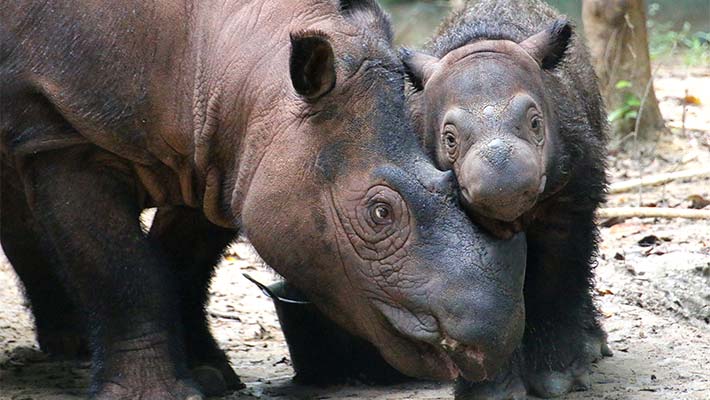Small and hairy
Sumatran Rhinos are the smallest and hairiest of all the rhino species and the closest living relative of the Woolly Rhino that lived during the ice age.
They love to spend their time wallowing in mud holes and licking salt from natural mineral springs and rocks.
A Rhino's horn
Sumatran rhinos have two horns. The front horn is larger and measures 10 - 31 inches (25-79 cm) long. The second horn is smaller, generally less than 3 inches (10 cm).
The horn is made from a protein called keratin, the same substance as hair and fingernails. Unfortunately, many people believe this horn can be used for medicine, causing the rhinos to be illegally poached. This combined with habitat loss has caused the Sumatran Rhino to become a critically endangered species.
Cool as a cucumber
Rhinos risk overheating under the hot tropical sun, and they lack sweat glands that would help them cool off. So, whether they live out on the plains, in marshes or in dense jungles, they routinely seek out water to help rid themselves of excess heat.
Their hide, dark red-brown in colour, is covered with patches of short, dark, stiff hair. The hair helps keep mud caked to the body, which cools the hide and
protects it from insects.
Sharp as a tack
Sumatran Rhinos have a keen sense of smell and sharp hearing, and they leave a network of scented trails throughout the forest in order to find one another.
A steep decline
The Sumatran rhino is the most endangered of all rhinoceros’ species due to its rapid rate of decline. Because of poaching, numbers have decreased more than 70% over the last 20 years, with the only viable population now in Indonesia.
Grabbed by the horns
Rhinos are famous for their horns but this famed body part has also been their downfall. Many animals have been killed for this hard growth extremity, which is revered for medicinal use (though scientifically unproven) in China, Taiwan, Hong Kong, and Singapore.
Habitat fragmentation
Human development has divided landscapes where rhino live, leading to small isolated pockets of populations that cannot come together to breed.

Come and meet us
Taronga is a founding member of the International Rhino Foundation (IRF) and whilst we do not have Sumatran Rhino on exhibit in Sydney or in Dubbo, our vets, pathologists, reproductive biologists and tourism staff are actively engaged in projects with the Sumatran Rhino Sanctuary at Way Kambas National Park, Sumatra. We also support Rhino Protection Units to prevent and prosecute wildlife criminals.